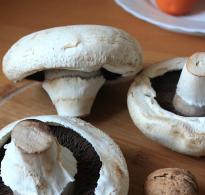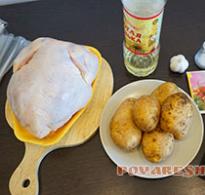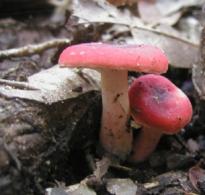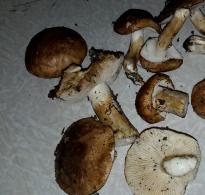Which condensed milk is better? Expert assessments. The right dessert: How to choose condensed milk How to choose condensed milk guest
Natural condensed milk, loved by everyone since childhood, does not contain preservatives, dyes, or taste improvers. The composition of such condensed milk should include only milk and sugar. The rules for the production of condensed milk were established more than 150 years ago, but now on store shelves you can find anything but a natural product. There is one good way to test the quality of condensed milk at home: try boiling the milk. If it is natural, then the condensed milk will become viscous and viscous. If the product contains starch and vegetable fats, the condensed milk will pour out of the can.
Previously, condensed milk was produced only according to the classic recipe. Nowadays, very economical manufacturers have come up with a lot of tricks with which they make fakes that taste no different from the natural product. Vegetable fats and starch significantly reduce the cost of condensed milk, but deteriorate its quality.
How to choose high-quality condensed milk?It would seem that everything is simple - if there is GOST on the packaging, then the product is natural. In fact, many manufacturers use different tricks. They can indicate GOST, but not the one that sets the rules for the production of condensed milk, but the one that shows the standard for packaging the product. Natural milk has GOST R 53436-2009. Natural condensed milk should be called simply - “Skinned condensed milk with sugar”; the following options are also allowed: “Condensed cream with sugar” or “Whole condensed milk with sugar”. Varenki, Condensed milk, Condensed milk and so on cannot fit into the category of natural product.

However, even if the product label only lists sugar and milk, this cannot mean that this is a quality product. The manufacturer can still add some chemicals to condensed milk, but at the same time not include the name of the harmful substance in the composition.

Condensed milk also choose by packaging. The symbol of quality has always been an iron can with a blue and white label. Today, packaging is diverse: “mayonnaise” bags, plastic containers, cups and tubes. Is there a difference between milk in different packaging? In principle, condensed milk retains all its qualities in any “shell”, but there is one complaint according to GOST. Natural condensed milk should only be in a tin can. The composition of a product sold in a different package must be studied very carefully.
all posts by the authorCondensed milk- the product is very tasty and loved by both children and adults. However, many understand that not all manufacturers are conscientious about the production of this delicacy. That is why today we will talk about how to choose condensed milk that is not only tasty, but also healthy for the whole family.
Let's start with what criteria you should use to choose condensed milk in a store:
1. Label.
When choosing condensed milk, look at its label and read what it says. Good condensed milk must be made in accordance with GOST. In addition, real condensed milk can only be called:
Whole sweetened condensed milk
Condensed cream with sugar,
Skim sweetened condensed milk.
If the delicacy is called “Condensed milk”, “Condensed milk”, “Boiled condensed milk”, Condensed milk and cream”, “Varenka” or has other names, this means that it contains substitutes for natural substances. It's better not to buy such a product.

low quality condensed milk

the best condensed milk according to the test purchase result
2. Packaging.
Condensed milk can be produced in metal or plastic containers. Both types of containers do not affect the taste and quality of the product, provided that the manufacturing technology has not been violated. Therefore, you should not buy condensed milk in deformed or dented cans. In addition, even after opening condensed milk at home, it is best to pour it into glass jars.
3. Contents of the jar
Color. Good condensed milk has a white color with a cream tint. If the product has a greenish tint or light brown color, it means it is of very low quality or its manufacturing technology has been violated.
Consistency. It should be homogeneous, without lumps and sugar crystals. The sandiness and mealiness of the product indicates its poor quality.
The sugariness of condensed milk is a sign that it has expired or is about to expire.
Smell and taste good condensed milk should be clean (without foreign aromas and tastes) and have a pronounced taste of milk.
Product defects Under no circumstances should it be used:
Presence of dark spots or mold under the cover
Bitter, musty, rancid or other odor
Swollen, dented or deformed cans
Foreign impurities in the product.
According to the results of the well-known TV show “Test Purchase”, which takes place on Channel One, the brand became the leader among condensed milk "Alekseevskoe"- http://www.aif.ru/health/food/1110801.

Alekseevskoe whole condensed milk with sugar - the best product our industry has to offer today.
Condensed milk is a very healthy nutritious food product that is obtained from whole cow's milk by removing part of the water from it and further processing. Condensed milk retains all the beneficial properties of milk, despite the fact that it is subjected to heat treatment for condensation.
Compound condensed milk is rich in important amino acids and vitamins; 100 g of product contains:
- PP (0.2 mg),
- B2 (0.2 mg),
- B3 (0.8 mg),
- B6 (0.1 mg),
- B9 (2 mg),
- B12 (0.4 mg),
- E (0.2 mg),
- choline (29 mg).
Microelements are preserved in condensed milk (per 100 g):
- potassium (318 mg),
- phosphorus (224 mg),
- sodium (124 mg),
- calcium (282 mg),
- magnesium (30 mg),
- sulfur (69 mg).
Calorie content of condensed milk
The main components of this food product are cow's milk and sugar, so condensed milk is a very high-calorie product. It consists of 8.5% saturated fatty acids and 35% milk. The moisture content is no more than 26.5%.
Due to the high content of fat (8.5 g), carbohydrates (56 g), and protein (7.2 g) in 100 grams, this sweet product is not recommended for people with diabetes, as well as those on a diet.
The energy value of condensed milk is 328 kcal per 100 g. Of these, 29 kcal are from proteins, 77 kcal are from fats, 222 kcal are from carbohydrates. The good news is that, unlike many sweets, condensed milk is very healthy.
Beneficial features
The process of converting milk into condensed milk occurs at a temperature of 60 degrees, which allows the maximum amount of vitamins and microelements contained in the original product not to be destroyed and preserved. Therefore, it is no less useful than whole milk. The difference between them is in fat content, the presence of sugar, shelf life, but most importantly, condensed milk is better absorbed by the body than whole milk containing lactose.
In addition, microelements and vitamins retain their beneficial properties for a long time (1 year). Real condensed milk replaces whole milk products, supplying the body with the necessary nutrients.
Unfortunately, nowadays, in the production of condensed milk, they increasingly deviate from standards and prepare it from skimmed milk powder, cheap vegetable oil, and unnatural ingredients. Such a product is not beneficial, but harmful to health.
How to choose real condensed milk
- NAME. “Condensed milk” and “Condensed milk” are not the same thing! Only the name “Condensed Milk” is protected by law. The manufacturer does not have the right to add any vegetable fats to the jar with it. And palm oil - first of all.
- GOST Choose jars that indicate GOST. The quality of condensed milk is regulated by GOST 2903-78 and the newer GOST R 53436-2009.
- MANUFACTURER. Large and reputable factories are more scrupulous about the quality of their products, they are checked more strictly, and it is for them that the “tarnishing” of their reputation is most dangerous.
- COMPOUND.
The composition of condensed milk according to GOST is only:
- cow's milk or cream
- sugar
- stabilizers - some sodium - or potassium containing substances
- antioxidant - only ascorbic acid.
The important thing is that condensed milk can easily do without the last two components. They are added only to those canned milk products that need to be stored for a long time.
5. APPEARANCE OF THE CAN. Iron, which is part of the can material, can have a very negative impact on the condition of the milk itself. As a rule, to protect milk from contact with iron, the wall of the jar is coated with a thin layer of a special substance. If the can is deformed, this layer at the bend may crack. The consequences can be different, so it is better to leave crumpled cans to continue standing on the shelf.

The abundance and variety of goods in stores and supermarkets force consumers to stand in front of the shelves for a long time, choosing the best. - this is an amazing product of nature, which contains almost all the substances we need. Condensed milk retains many of the beneficial properties of milk. This is a nutritious, tasty and familiar product to everyone since childhood. Condensed milk can be consumed as a delicacy or added to, and used to prepare various confectionery products. In order not to become a victim of counterfeit products, let’s figure out what the correct condensed milk should be.
Package
Condensed milk is produced in metal or plastic cans. The most common one is metal, although plastic is more convenient and lightweight. Neither plastic nor metal packaging affects the taste of the product, provided that they are manufactured without violations of technology. You should not buy condensed milk in damaged or dented cans, because... the metal in them may crumble. The taste and appearance of milk deteriorates. Remember, the can should not be bent or deformed, because... In this case, dangerous elements contained in the iron could get into the product. Even if the metal can has the correct shape, experts recommend pouring the milk into glass jars after opening. When buying condensed milk in non-standard packaging, read the label very carefully - modern packages often contain milk-containing products that have nothing in common with natural condensed milk.
Marking GOST (DSTU)
The most important indicator and indicator of the authenticity of a product is the GOST badge (or DSTU for Ukraine). Only “GOST” products are the best, because in condensed milk produced according to specifications, various composition options are possible. This is due to the fact that the manufacturer legally uses its own recipe.
According to GOST R 53436 - 2009, condensed milk is divided into condensed cream with condensed milk, skim condensed milk with sugar, and whole condensed milk with sugar.
These products mainly differ in fat content, and the fat content of sweetened condensed cream is at least 19%, the fat content of whole condensed milk with sugar is exactly 8.5%, and the fat content of sweetened condensed milk does not exceed 1%.
Any other names - “Condensed milk”, “Varenka”, “Condensed milk”, “Special condensed milk”, “Condensed milk and cream”, “Condensed milk with sugar”, “Dietary condensed milk”, “Boiled condensed milk” or even just “Condensed milk” " means that various additives and substitutes for natural products were used during the production of the product. Such a product has absolutely nothing in common with “true” condensed milk.
Designations on the can
Carefully examine the can of condensed milk and absolutely all the embossed symbols. The first letter on the lid should be the embossed letter M - this marking is used to indicate condensed milk. The next two digits are the manufacturer's code; these numbers may vary. They are followed by two or three very important numbers that indicate the product range. It is best to focus on 76; this is the number that hides condensed milk with sugar without extraneous additives. The bottom row is the production date. The shelf life of natural condensed milk is only 12 months, combined, i.e. with additives and substitutes, can be stored a little longer.
Compound
Rospotrebnadzor conducted a small study last year, the results of which are shocking - 90% of condensed milk on the country's domestic market contains a large amount of vegetable fats. Manufacturers do not even indicate any information about this on the packaging, depriving us of freedom of choice! The situation on the Ukrainian market is not the best.
Manufacturers most often sin with palm (or coconut) milk, as well as titanium dioxide (this is E-171). Everything is clear with the first ingredient - it is much cheaper than natural milk. The second one raises big questions. E-171 is an inorganic pigment, it is a tasteless and odorless dye, a white amorphous powder. It is used to produce paper, rubber, paints and varnishes and... condensed milk.
So, according to GOST, the composition of condensed milk and cream includes only raw cow's milk or cream, as well as sugar and drinking water. Only ascorbic acid is used as an antioxidant, and some sodium or potassium derivatives are used as stabilizers. That's all! There should be no vegetable fats, sweeteners or preservatives!
If the packaging contains the following ingredients: palm oil, pectin, starch, whey powder, milk fat substitute, synthetic dyes, etc., then the condensed milk does not meet the quality standard and is not “real condensed milk.” This product is only vaguely similar in taste to condensed milk.
Checking condensed milk for the presence of vegetable oils
Method number 1. The condensed milk needs to be boiled. If boiled condensed milk does not flow even from an inverted jar and is very thick, then the product is really made from milk. If the condensed milk remains liquid after cooking, it contains vegetable fat. Typically, when heated, natural milk becomes thicker, unlike vegetable fat, which remains liquid.
Method number 2. Place a teaspoon into the jar. In real condensed milk the spoon will not fall. Before the experiment, check the condensed milk for thickness. According to GOST, its consistency should not be too thick, but not too liquid. The viscosity of dessert is easily determined by a special device in laboratories. You can also expose a fake at home. To do this, you need to stir the condensed milk in a jar. Excessive fluidity or thickness, as well as uneven structure, should alert you. Scoop a small amount of condensed milk into a teaspoon and watch it start to drip. A thin continuous stream means that this is real, correct condensed milk and you are lucky with your purchase.
Best before date
Please pay attention to the expiration date of the product. Typically for a metal can it is 12 months, for a plastic can it is 2 or 3 months. If condensed milk is packaged in a store by the seller, it can only be stored for a few days. Of course, you should not buy expired products. By the way, even “correct” condensed milk, made from natural ingredients in accordance with GOST, may turn out to be of poor quality. This is primarily due to improper storage. Despite the fact that condensed milk is a canned product, it is very sensitive to improper storage conditions. Condensed milk should be stored in a cool, dry place, at a temperature of 0°C to +10°C, but when the shelf life expires, the condensed milk begins to sugar. Having opened the package of condensed milk, carefully examine its contents: if the expiration date has not yet expired, but the condensed milk has already been candied, this means that it was stored in the heat or cold.
Studying the contents
1. Proper condensed milk is usually white with a slight creamy tint. Light brown appears only if the entire technological process took place at high temperatures. Powdery consistency and white with a slightly greenish tint indicate low quality of the product.
2. The consistency of condensed milk should be homogeneous throughout, without the presence of milk sugar crystals. Is the product too thin? This means that there was little protein in the starting material. If, on the contrary, the condensed milk is too thick, milk with high acidity was used during production and the protein curdled during condensation. Sandiness and mealiness also indicate a very low quality of the product. Storing the product at high temperatures may be one of the reasons for thickening.
3. If the condensed milk is candied, then the expiration date has either expired or is coming to an end.
4. If you find dark spots or mold under the lid, you should absolutely not eat such a product. Such “surprises” most often appear on the lid due to violation of sanitary conditions in production.
5. The smell and taste of condensed milk should be sweet, clean, with a pronounced taste of pasteurized milk. You should not experience any foreign tastes or odors. A pleasant, light feed taste is allowed. Taste defects include rancid, bitter, fishy flavors and musty odor.
6. If you find foreign impurities in the purchased condensed milk, feel free to return the can to the store. The dessert should only have a uniform consistency. Condensed milk should not pour out of the jar abundantly, nor should it fall out in pieces. Such milk is considered to be of poor quality.
7. Lumps in condensed milk do not just appear. Their occurrence is facilitated by spores of brown-chocolate mold, which penetrate the product and “kill” its quality. Lumps also indicate poor sanitary conditions of production.
8. If the condensed milk is light beige or gray in color, the production technology was significantly violated, or ingredients were used that should not be in condensed milk.
9. Under no circumstances should you eat the contents of a swollen jar, because... this indicates the presence of dangerous harmful microbes.
10. A sign of low-quality condensed milk is the presence of starch in its composition. It is added to artificially thicken milk, as well as to improve its appearance. The presence of starch in condensed milk significantly spoils the taste of the product.
How to cook condensed milk
To get a tasty treat, buy condensed milk with a fat content of at least 8-8.5%. Pay attention to the composition of condensed milk: it should not contain any impurities or vegetable fats. Such condensed milk will not cook. The composition should ideally include only milk and sugar. Before cooking, remove the paper label from the jar. Place the jar in a saucepan and fill with cold water. The condensed milk should be boiled for 2-3 hours, and throughout the entire time the jar should be completely covered with water. Calculate the required amount of water in advance.
Now place the pan with the jar on high heat. After the water boils, the heat must be reduced to a minimum and continue to cook the condensed milk until completely cooked. If the liquid from the pan has boiled away, add a little hot water. Under no circumstances should you add cold water, otherwise the can of condensed milk will explode. After two to three hours, let the jar cool.
We wish you a good choice!
Roskoshestvo recently tested the quality of condensed milk from different manufacturers. It turned out that most of the products tested do not meet accepted standards: many products that are passed off as high-quality condensed milk are of low quality and harm the health of consumers.
Stamps you should never buy
The can of Rogachev condensed milk contains inaccurate information about the composition: a check showed a high amount of added phosphates, which are not mentioned in the labeling.
Moreover, the actual mass fraction of fat is less than that indicated on the label - 8.3%, not 8.5%. Another disadvantage of this condensed milk is the increased level of viscosity.
More deviations from the norms were identified in Glavproduct condensed milk:
- incorrect information in the labeling about the proportion of fat (5 times less) and protein (half as much);
- based on the actual proportion of protein and fat, it cannot be called “whole condensed milk with sugar”;
- the actual composition of this condensed milk does not match what is indicated on the label;
- whey powder is used instead of condensed milk.

The brand “Favorite Classics” also cannot be called a quality product. The mass fraction of moisture in condensed milk is increased. The mass of milk protein does not comply with technical regulations and standards for physical and technical indicators.
The composition may contain added phosphates that are not mentioned in the composition.

"Dairy Country" has a high level of viscosity, the actual fat content is 12% less than stated. Samples of this condensed milk also do not correspond to the composition on the packaging, since it contains phosphate.
The GOST on the label also does not correspond to what is stated: the content of fat, sucrose and purity group do not match.

JSC "Verkhovsky Milk Canning Plant" does not meet the standards due to an overestimated mass fraction of moisture. A very low protein content (2.2%) was found in the product, including 15.6% in the dry fat-free residue. The reason for such discrepancies with standards and labeling is the addition of whey or soy protein emulsion.
Safe and healthy products
Several samples nevertheless passed the test: they have a uniform consistency and appearance and a uniform color throughout the mass. Among them are condensed milk:
- "Cow from Korenovka" A completely safe product: its fat content is the same as indicated on the label, condensed milk does not contain vegetable fats. The nutritional information and composition are accurate.

- "Alekseevskoe". Condensed milk passes Roskachestvo tests according to all requirements: it has a normal degree of viscosity, milk processing by-products are not added to it during the production process. Sucrose levels are also normal.

- "Spock "Karlamansky milk". This product is made from natural raw materials, as evidenced by physical and technical indicators, without the addition of starch, sorbic acid and other preservatives.

- "Favorite." Tested for compliance with technical regulations. No phosphates or preservatives are found in the composition, the nutritional value corresponds to the label. The labeling of this condensed milk is accurate.

- "Volokonovskoe". The product label information is accurate. Organoleptic tests revealed no lactose or foreign impurities. Condensed milk has a uniform consistency and a purely pronounced smell of pasteurized milk.

Half of the tested products that continue to be sold in supermarkets are of unsatisfactory quality and are sometimes unsafe for consumers. However, high-quality and healthy condensed milk is still produced, but finding it on your own among a wide range of products can be difficult.






